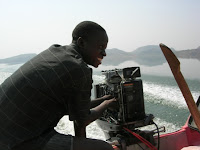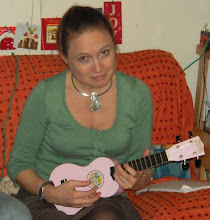Last Tuesday one of my blog readers in the UK emailed me to profess a pang of envy as my blog showed pictures of hot sunny days just as England was moving from Arctic freeze into a mild, wet and miserable January. Well take heart – at the same time in Kafanchan we have begun experiencing in earnest the baking heat associated with clear blue skies and bone-dry air thick with dust blown from the Sahara by the hot blast of the harmattan wind. On that night the heat was temporarily broken by a fierce and unexpected thunderstorm that blackened the sky and rattled every corner of our house (particularly the tin roof), although thankfully did not blow any part of it down or expose any leaks or cracks.
The temperature built up again rapidly so that by our journey home to Kagoro on Friday afternoon, a long and tough week at work combined with heavy deadlines for budgets and business plans across the organisation, baked at gas mark 8 in the hot sun, led to some frustration and exhaustion. Not only was the weather hot, but so was the work, as we discovered they say in Hausa.
On Wednesday night we had our first Hausa lesson, delivered to us by one of our neighbours, Victoria, older sister of Marvellous, one of Laurie’s regular garden helpers and street footballers. The first lesson was on Greetings, an essential element of Hausa culture which can happily take the first 5 minutes of any conversation. Strangely though, there is typically only one answer to every question: Lafiya, meaning fine.
Sannu, ina kwana? (how was your night?) –
lafiya
Ya ya gida? (how is your home?) –
lafiya
Ya ya senyi? (how is the cold?) –
lafiya
Ya ya aiki? (how is work?) –
lafiya
Ya ya yara? (how is the family) –
lafiya
Well – us ‘northerners’ (or westerners, or batauria – take your pick) like to be a bit more descriptive.
"
How is work?" So we asked Victoria,. How could we say: “
Work is pretty tough”?
“
Ayiki akwoi zafi yo” she replied after trying to encourage us to simply say ‘
lafiya’. We asked her to translate word for word. “
Work is hard” we thought she said, with the traditional Nigerian shortening of the ‘ar’ so that ‘heard’ resembles ‘hat’ or ‘cared’ as ’cat’.
Laurie then wanted to know how to dispute the existence of nocturnal cold: ‘
ya ya senyi?’ – we will be asked on a Winter’s morning having passed ocada drivers wrapped in thick anoraks with woollen gloves and hats, and school children hugging their arms in thick cardigans, whilst some of us still awake in a sweat. “It’s not cold, it’s hot,” we requested for translation. “
Ba senyi, akwoi zafi yo”. Then the penny dropped. “
Ayiki akwoi zafi yo” doesn’t mean "
work is hard", it means
"work is hot.."
And boy is work hot at the moment. I always used to (probably unwisely) tell people (usually bosses) who would question my late nights at work, that my long hours made up for the fact that “if I tell you I’m working at the weekend or at home, I’m lying”. In London I just couldn’t work at home.
Here it’s different. Whether it is because we have an enforced office leaving time of 16:30 – 17:00 when our driver arrives to ferry us back to Kagoro, or whether the work is simply more inspiring; whether there’s simply too much to do at work or whether there’s just simply nothing else to do in the evenings - I have become far more accustomed to working at home, or at weekends.
Tomorrow all the residents of the Pink House will be going into work. With budget deadlines looming – OK let’s be perfectly honest – passed, and so many other things to do, there simply isn’t enough time in the day. Here’s an illustration of my current projects (and I’ll be copying this for tomorrow’s ‘To Do’ list – I’m not kidding!):
- Create the Fantsuam Foundation marketing plan and budget
- Finalise the microfinance department’s business objectives, bonus system and budget
- Work with the Zittnet team to plan the implementation of USPF Community Communications Centre grant into the Zittnet budget and business plan
- Proof-read the Gaiya training manual (all 50 pages – goody!)
- Work with Child Parliamentarians to build a grant proposal from OSIWA to support FACC
- Complete my VSO placement review Preliminary Report and discuss with John and Comfort
- Build a concept description of Attachab – Fantsuam’s site for an EcoFarm
- Research and if appropriate complete a submission for FF’s microfinance department to register with fund-raising website Kiva
- Meet with local musician Boman to finalise his business plan for launch of a new album
- Seek input from colleagues and suppliers to determine the plan and timing for the Fantsuam Foundation Progress and Prosperity Opportunity Showcase
- Complete a 1pp overview of Fantsuam for the first Euro-Afro ICT Cooperation Event 2009 (EAICE), taking place in Uganda in May 2009
- Work out how to back-up my laptop (OK it’s probably a bit late but I am thinking about it!)
And I would not like to give the impression that I am working alone on any of these projects. This list is typical of most of my colleagues – sometimes I wonder how anything gets done. However I have recently taken note of a wonderful quote by D.B.C. Pierre in the 2003 Man Booker Prize Winning Novel ‘Vernon God Little’:
“Once you plan to do something, and figure how long it'll take, that's exactly how long Fate gives you before the next thing comes along to do.” I now try to start doing everything when I think about it, which doesn’t always fit in with careful pre-planning. I do believe that it is this philosophy (which appears to come from the top at FF), rather than endless planning, which has made Fantsuam the successful organisation that it is today, particularly in the context of Nigeria.
One of FF’s UK partners, Marcus Simmons of Ecoshelter, who has been working with Fantsuam for a short time observed that this method of working is:
“Ramshackle but happy and oddly effective..” That goes for pretty much everything here and could lie behind Nigeria’s top listing in the New Scientist’s ‘happiest people’ poll.
It can feel frustrating at times, particularly when you’re used to ‘western’ working practices however Marcus gave me another invaluable piece of advice: “Don’t worry about gap below the ideal, just that anything you can do above current status quo is progress”. And I only have to take visitors around the Bayan Loco site to remind myself what an effective NGO Fantsuam is. When you put the activities of Fantsuam into this context you feel positively exhilarated!
As many of you will know I travelled to Abuja on Wednesday to collect three short-term volunteers, all head teachers in the UK, who are working with the DFID-supported ESSPIN (Education Sector Support Programme in Nigeria) who were visiting the volunteers in Kafanchan and Gidan Waya (College of Education). I know (because they emailed me to say so!) that they were genuinely impressed with Fantsuam as I showed them the class rooms full of Computer Certificate students, the Knowledge Resource Centre being used by research students of all ages, the busy microfinance office with its enthusiastic field officers, the Network Operations Centre with its server room and banks of batteries and power inverters capturing energy from unreliable NEPA and the more reliable sun, the HIV counselling centre with demonstrations of test kits and stories of home visits where counsellors try to convince affected mothers to keep their mosquito nets for themselves rather than for their healthy children, or the Health Centre that was busy with patients that we were unable to enter. And that’s just the parts of the organisation you can see.
When I first arrived I remember writing a blog about ‘The Wonderful World of Work’ which ended with the line:
“It is within this environment that I, the other VSOs and all the Fantsuam colleagues and volunteers come to work every day and believe me, it's a lot more inspirational than the short walk from Liverpool Street Station to Worship Street, London EC1.”
Well three months in to my VSO journey it’s still true, although sometimes I wish it wasn’t quite so ‘hot’.
 Ring the bells that still can ring
Ring the bells that still can ring













































































